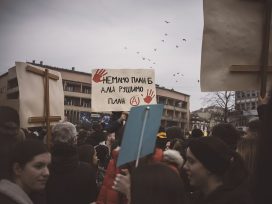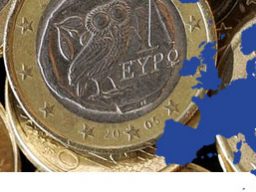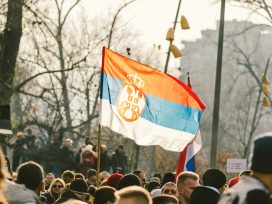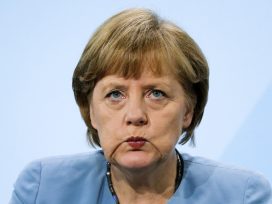Iceland is like a human experiment. Leave 300,000 people on an island and see what happens. In many ways, Iceland is a strange place, and what happens in Iceland on a small scale can reflect far bigger forces in this world. Marketing experts sometimes use Iceland to test-run products or marketing campaigns – of course without letting us know. If they are successful in Iceland, they take the campaign into the wider world. The same applies to ideas, literature, movies and music. Although there aren’t many of us, we have somehow managed to create a pattern which isn’t monotonous – on the contrary, in fact; lots of opposites in proportion with the opposites found in larger societies. Here you can see clearly how large ideas have a direct impact on people’s daily lives.
Throughout the centuries, Iceland has for the most part had little to do with the big events of world history. But here you can nonetheless see a miniature image of world events. In 1986, Reagan and Gorbachev met in Reykjavik – Hofdi, the white timber house where the summit took place, marks the beginning of the end of the Cold War, the dissolution of the Soviet Union and the fall of communism. That meeting would eventually lead to the closure of an army base in Iceland, leaving a thousand people jobless. Next door you can find the headquarters of Kaupthing Bank – where super-capitalism collapsed in Iceland following the collapse of Lehman Brothers – just before the entire global financial system went the same way.
On an island just off where Hofdi stands there is a gigantic ray of light pointed skywards: the Imagine Peace Tower, designed by Yoko Ono in memory of John Lennon. From there you have a clear view into the fjord of Hvalfjordur, with its gigantic aluminium smelter which uses up more energy than a city of one million people. Priceless expanses of land in Iceland and Jamaica were sacrificed to power this factory and provide it with raw material. Still, it only produces a mere fraction of what the world annually throws away in cans and disposable aluminium packaging. Not far from Hofdi is a small steel hut, a tiny wisp of steam emerging from a chimney attached to the building: the only visible sign of the geothermal energy pumped out of the ground to heat up the city, the steel hut a mere fraction of one of the biggest geothermal energy programmes in the world, which on a yearly basis saves thousands of tonnes in carbon fuels. It is thought that around 600 million people worldwide could make use of a similar technology, thereby providing ten per cent of the world’s energy.

Global problems are a collection of a million local problems and challenges people face in their daily lives. Understanding how we react to local problems can sometimes lead to a slightly better understanding of how the world works.
At the beginning of the twentieth century, Iceland was one of the poorest nations in Europe. Immediately after World War II, however, a there began a rapid process of modernization. In around 1980, living standards were on a par with the most advanced western societies. A completely modern society with hospitals, schools, swimming pools, theatres and discotheques. Iceland had the highest life expectancy in the world, along with Japan, and the infant mortality rate was one of the lowest. Almost 80 per cent of all energy used in the country was local, clean and renewable – long before the debate on global warming began. The nation had embraced modern life and retained its language, equality was rife, there was little class division, the majority of the country’s territory consisted of unspoiled nature, and the nation had voted into office the world’s first democratically elected female leader. From this point onwards, the nation’s industries should have developed slowly and surely in a variety of directions.
When the global recession crisis hit, Iceland suddenly made world news. The headlines were breathtaking. Collapse, national bankruptcy and demonstrations on the streets. In Vanity Fair you could read descriptions of burning Range Rover jeeps and people stocking up on groceries. Actually, neither story was true. One man was suspected of having set his luxury car on fire and Iceland continued to export fish. The collapse, however, was a fact. Iceland was one of the worst casualties of the global financial crisis. The Icelandic stock market, which at its peak had reached 9000 points, stood at 14 points after the collapse. This rollercoaster ride was as dramatic as the statistics.
In the five years between 2002 and 2008, Icelandic banks had gone from serving a small local market to operating as large international corporations. They grew tenfold and had become twelve times richer than the Icelandic gross national product. Their sights were set even higher: every single bank possessed drawings of new headquarters which were supposed to be ten times larger than those they had in 2007.
The banks employed a young generation full of confidence – they knew their way around the business districts of London, New York, Tokyo and Shanghai. They were highly educated with postgraduate degrees from Harvard, MIT and LSE. They spoke more languages than their parents and knew how to put together complicated financial transactions, forward contracts, derivatives and all those things ordinary people don’t understand. This was the most highly educated generation in Icelandic history and the banks had an insatiable need for educated manpower. They became a black hole for talent, sucking in the best people. A good geoscientist or physicist received training in risk management, electrical engineers were recruited to asset management, computer programmers to currency trading and collateralized debt obligation, while meteorologists and historians ended up in market analysis. The average stockbroker was receiving a wage no director of a normal company could afford to pay out to him or herself. Good employees were leaving well-run businesses to join the banking adventure. Ordinary people wondered: how can a bank make ten million dollars out of buying and selling a company which hardly returns a profit? Analysts were always at the ready to provide educated explanations. They practiced the latest methods in international finance – used the latest schemes taught in international business schools, the same as age-old institutions such as Lehman Brothers and Bear Sterns.
Young, rich males became national icons – wizards who overnight were able to make profit a thousand times higher than the annual wages of a normal person. Success was the key word. They ran enormous gambles, financed leveraged buy-outs, paying out sky-high wages to themselves. They made use of the Icelandic nation’s decades-old goodwill to build up gigantic business empires. They gained access to what appeared to be an almost unlimited amount of credit from the United States, Germany, Japan and the United Kingdom. Money was flowing through the banks and regularly we heard reports of how rich our nouveau riche were – but not how much they owed. The Icelandic state was almost debt-free and, for most, Iceland was still a traditional Scandinavian democracy.
Thus began an extraordinary and extreme era. One man bought a helicopter and got Elton John to sing at his birthday party. Another got the rapper 50 Cent to perform at his fortieth birthday party, Duran Duran played at a New Year’s Eve party hosted by Kaupthing Bank in London. Landsbanki sent two plane-fulls of customers to Italy where people were served pasta – seasoned with flakes of gold. “I thought only the gods ate gold,” a party-goer was quoted as saying. For the first time, the Icelandic people began to experience an actual class division. The bankers were living in a different world. Word got out that in the banking world, the airlines’ economy class was referred to as “monkey class”. Others believed the real monkey class to be in the private jets, quoting a saying from the Poetic Edda, written in the twelfth century: “Money turns many a man into a monkey.” This ancient saying was proven true sooner than most people would have expected.
In October 2008, the banks collapsed one after the other and the government took over their management. Glitnir Bank was the first to go, then Landsbanki and finally Kaupthing Bank – which was by far the largest company in Iceland. According to credit rating agency Moody’s, Kaupthing’s bankruptcy was the third biggest in the world since the year 1920 – amounting to just over 20 billion dollars. The bankruptcy of Glitnir Bank was the fifth biggest. Landsbanki wasn’t far behind. These amounts are nothing next to the biggest bankruptcy of all, the collapse of Lehman Brothers, which holds the record at just over 120 billion dollars. But for a nation of 300,000, these are astronomical amounts.
The Icelandic nation watched, shell-shocked, as events unfolded. The British government made use of anti-terrorist legislation to freeze Landsbanki’s assets in the United Kingdom. Landsbanki had opened online savings accounts in the United Kingdom and the Netherlands, and gathered billions of euros from tens of thousands of individuals, charities and local councils. The legislation had been put in place after 9/11 and was now being used for the first time in a context which had nothing to do with suicide attacks, bombings, kidnappings or extremism. On the British Treasury’s website you could read a list of nation states and groups to which the laws had been applied, and it was certainly frightening company to keep: The Taliban, al-Qaeda, Iraq, Syria, North Korea – and Landsbanki. There were no Italian mafia companies listed, no arms smugglers, no Nigerian money launderers or Columbian drug barons. Al-Qaeda and Landsbanki. The application of the anti-terrorist laws caused Iceland enormous economic damage and didn’t serve to lessen the effects of the global financial crisis. Even though the bank was a privately owned bank operating in the United Kingdom, it was Icelandic, and the Icelandic taxpayers were obliged to guarantee these deposits. The total comes close to the Icelandic gross national product, and there are many indications that the payment burden of Iceland could be larger than that of the Treaty of Versailles. The dream of Iceland becoming a global financial centre was turning into a nightmare. The bubble money was to be paid for with tax deducted from the hourly wages of people who had nothing at all to do with this nonsense. The public went berserk – people surged into the streets and the government was forced to resign and call an election. The unemployment rate has gone up and people’s debts in foreign currencies have doubled since the national currency collapsed. Some have mortgages twice as high as their house’s actual value. How could this have happened?
My novel LoveStar was published in Iceland in 2002. In hindsight, there was probably something in the air that I could feel, some madness, some hubris, some fantasy that was leaking into our reality, where money could be created from nothing. The Icelandic stock exchange rose from 1000 points in 2002 to 9000 points in October 2006, the month I published my book Dreamland: A Self-Help Manual for a Frightened Nation. Some might be surprised at the book’s title – when Iceland was on its way to becoming an international economic marvel, how could the nation have been frightened at that point?
However, as early as 2002 it was clear there would be a crash in Iceland. When the financial system collapsed in 2008, the IMF issued a statement on the causes of the Icelandic collapse:
Executive Directors observed that the Icelandic economy is at a difficult turning point. The long economic expansion, initiated by aluminium sector investments, sustained by a boom in private consumption, and fuelled by ready access to external financing, contributed to a build-up of macroeconomic imbalances and financial vulnerabilities.
The collapse of the Icelandic economy can be traced to the fact that politicians decided to try out two major social experiments concurrently. One of them was a revolutionary five year plan, on an almost Soviet scale, to double Iceland’s electricity production in order to power an aluminium smelter owned by a large American company, Alcoa. This act alone – doubling the electricity production of a developed nation – is enough to kick off a gold rush. The energy would have sufficed to run a million homes; the scale equalled the energy requirements of Manchester, England. Waterfalls, valleys, terrains and the habitat of geese and reindeer were to be flooded behind the largest dam in Europe, a 190 metre high 700MW power plant. For a nation of 300,000, the investment was colossal – roughly three billion US dollars. The strength of the Icelandic krona grew to such an extent that the entire world was practically for sale; interest rates were increased to keep down inflation. But interest rates had the opposite effect: they became a magnet for capital from all over the world and currency sharks worldwide began to deal in kronur. If speculators had once been able to bring down the pound sterling, you can imagine what could be done to a tiny currency such as the krona. According to the government, the smelter and the dam would bring the nation much prosperity during construction – but it was a known fact that when construction ended, there would be a downturn.
As billions flooded into the country because of investment in the energy and aluminium industries, politicians got down to business, privatizing the country’s major banking institutions, thereby transferring a vast amount of power to a small number of individuals and companies. This was done in the spirit of the ideology of deregulation and the perfection of the free market, à la Milton Friedman. The motto was: “The more money each individual tries to make, the more is gained by society as a whole.” At first, this ideology worked like a charm. The banks exploited people’s optimism at the beginning of the energy gold-rush, pumping the economy full of loans in foreign currencies. One hundred per cent car loans, one hundred per cent mortgages and one hundred per cent loans to people taking over solid, family companies. The loans amounted to many times the national export revenue. Apartment prices doubled in a few years, the stock market grew ninefold. The public regarded all this affluence with a mixture of admiration and jealousy – while the gap between rich and poor grew ever larger. A hike in house prices made many feel as if they’d made tens of thousands of dollars. Icelandic men bought more Toyota Land Cruisers and Range Rovers than Norwegians, Danes and Swedes combined.
We saw examples of the incredible success of a handful of individuals – the Icelandic Dream incarnate. A father and son bought an old Icelandic brewery and began producing beer in St Petersburg, Russia. The company grew and prospered. Few were able to understand how that could be possible – in a city where Russian crime syndicates had a lot of influence. They sold the company to Heineken. They had 200 million dollars in cash – more than any Icelander had ever possessed. In 2003 they bought Landsbanki, Iceland’s oldest bank, and immediately started expanding it. Before it all ended they owned two banks, a telecommunications company in Bulgaria, a large pharmaceutical company, a shipping company, an airline and the football club West Ham United. The son got onto the Forbes list of the 500 richest people in the world.
A set of brothers started out small, selling roe to Japan and Germany. The company grew, eventually becoming one of the largest food manufacturing companies in Britain. They became the owners of Kaupthing, which soon became one of the largest banks in the Nordic countries. They bought Finnish and Icelandic insurance companies, a telecommunications company and had tens of thousands of employees all over the world. The last people heard, they were building a 600 metre square summer house – before everything collapsed.
Those who played a risky game and took over companies became billionaires. As long as stock continued to rise throughout the world, almost nothing could go wrong. Here in Iceland it happened right before your eyes: people changed from ordinary store managers into international sharks. In 1996 I made a deal with a chain of supermarkets to publish a book of poetry – Bonus Poetry. The book was a sort of literary prank, a mystical journey through a Bonus supermarket, starting in Paradiso, the fruit division, going to Inferno, the meat products, ending in Purificato, the cleaning products. It was a book for the ruling ideology; every ideology has come with poetry, but capitalist realism was missing as a literary genre. The first poem in the book was about the primal nature of man; his primal nature not being hunting but gathering. The last words of the poem read as follows:
I can feel how the primal man breaks forth
when I race with the cart
and I gather and gather and gather…
I made a deal with the supermarket’s owner. He sat in a small windowless office which he shared with three women who did the books for the 12 supermarkets belonging to the chain. Ten years later, this same man was employing nearly 50,000 people. He owned the big department stores in London and Copenhagen, a multitude of clothing outlets, a chain of toy shops, two chains of jewellers. He owned a black yacht, a matching private jet, a hotel, the large part of a bank, a Rolls Royce Phantom, the most expensive flat in Manhattan and leading media outlets in Iceland. He had put into practice what the first poem of the book was all about. The primal man had emerged as he gathered and gathered and gathered. When his company, Baugur Group, was declared bankrupt, his companies’ debts to the Icelandic banks came to around six billion US dollars.
By 2006 it had already become clear that the whole thing was getting out of hand. The credit market was starting to shut down; matters got worse in 2007 and 2008. The banks found a way of financing themselves by opening up high interest online banks for account holders in the UK, Germany and the Netherlands. They took advantage of Iceland’s solid reputation. Billions of euros flowed into these accounts and they were all guaranteed by the Icelandic people – without the knowledge of the majority.
The huge dam in eastern Iceland was almost complete. In order to avoid a downturn after the largest construction project in Icelandic history, the government aimed even higher with a new five year plan. Energy production in Iceland would again be doubled from 2010 to 2015, with two new aluminium smelters, making Iceland one of the greatest aluminium smelting sites on earth. We had created a sort of heroin economy: our addiction was to building energy plants and aluminium smelters. During construction, more money flows into the country than when the factories commence production. During construction there are more jobs available than in a working factory.
Suddenly, one natural gem after the other was in immediate danger. Delicate geothermal areas with colours and bubbling water, beautiful waterfalls, endless expanses – all had been put on the drawing board to serve a handful of multinational companies, turning them into economic superpowers. Almost anything could be sacrificed to maintain consumption, an overly strong currency, the flow of capital and work for contractors, and to create jobs in weak rural communities. The risk was large – the Icelandic people only used 20 per cent of the electricity compared with 80 by aluminium companies. Still, even more sacrifices were to be made and our energy companies to be placed in colossal debt. Because of aluminium production, by far the most energy-demanding industry in the world, we were faced with enormous decisions. The highlands and nature of Iceland suddenly became politically charged issues. Places only a few people had seen and experienced were making front page news. If this was to continue, the major waterfalls and geothermal areas would become industrial zones in a couple of years. Artists, natural scientists and outdoors enthusiasts fought a tireless battle to introduce the nation to certain areas before they fell prey to destruction.
The Chinese have a curse which goes like this: May you live in interesting times. In Iceland we are certainly living through some interesting times. The collapse is a fact. The unemployment rate is rising and a spate of bankruptcies is imminent. Still, many interesting facts have come to light and the lessons we can learn from this collapse are many and various.
When we create too many jobs through an immoderate encroachment upon natural resources or debt, we pull the teeth out of other industries and weaken the economy in the long run. Transparency and information are vital if a nation is to be able to make informed and democratic decisions. If every individual attempts to maximize his or her own gain but cares nothing for the national interest, everyone becomes a loser. If larger nations can learn from these mistakes, we’ll possibly have done something useful.
Recent research has shown that stock markets stir up the primal urges of man – particularly those of young men. They buy stock – if it goes up a higher level of testosterone can be measured in their saliva. Researchers have found that prolonged high testosterone levels can lead to irrational or impulsive decision-making, with disastrous consequences. When entire companies are manned with young, risk-seeking males, it is a recipe for disaster – it happened in Iceland, it happened on an international basis, it will happen on an international basis in the future if the gender ratio within the financial sector stays the same. Gender equality and a more diverse age range could possibly create a healthier market. When short-time gain is wired straight into your paycheck, the effect is the same as in a casino. We would appear to have set a good example after the collapse. Our new prime minister made world news because she is a woman and the first openly gay world leader.
Some interesting statistics have surfaced. Traffic authorities have reported that in Iceland, car accidents have gone down by 40 per cent during the first five months of this year compared with the same period before the collapse. Serious accidents have gone down by 13 per cent. Yet traffic has only gone down by 5 percent. Why? People are probably less stressed, in less of a hurry – and they show more consideration for others. There is probably less testosterone in the drivers’ blood.
The recession reminded people of the things that have true value – what is education worth when those considered our smartest brains have just about bankrupted their own nation? The swimming pools and theatres have been full, the ski slopes busy – unemployment has caused universities enrolments to increase. People have more time to spend with their children and grow their garden. Potato seeds sold out, along with vegetable seeds. Wool and knitting patterns are selling as never before. But that is not enough to pay the debt. We have a new government, half the members of parliament are new. We have everything to fulfil our basic needs. The schools are here and so is the knowledge for teaching. The fish are still in the sea, the energy is still in the ground, the language is still good for telling stories.
Economists speak of the invisible hand of the market, correcting the market when an imbalance arises. In Iceland, the imbalance had become such that an invisible guillotine was formed. Practically all the power attained by a few individuals evaporated overnight. The entire business elite was suddenly nowhere to be seen; a power structure with a grip on the media, business, even the arts, disappeared in a single week. A new government came into power, people who’d been active in the demonstrations formed a political party and got representatives elected into parliament. A decades-long process of privatization of state businesses and industries was almost fully reversed – without the revolution being ideological or bloody. We have arrived back where we started. Such a void is an incredibly interesting position – frightening, full of dangers and opportunities, full of uncertainties. Very interesting times.








